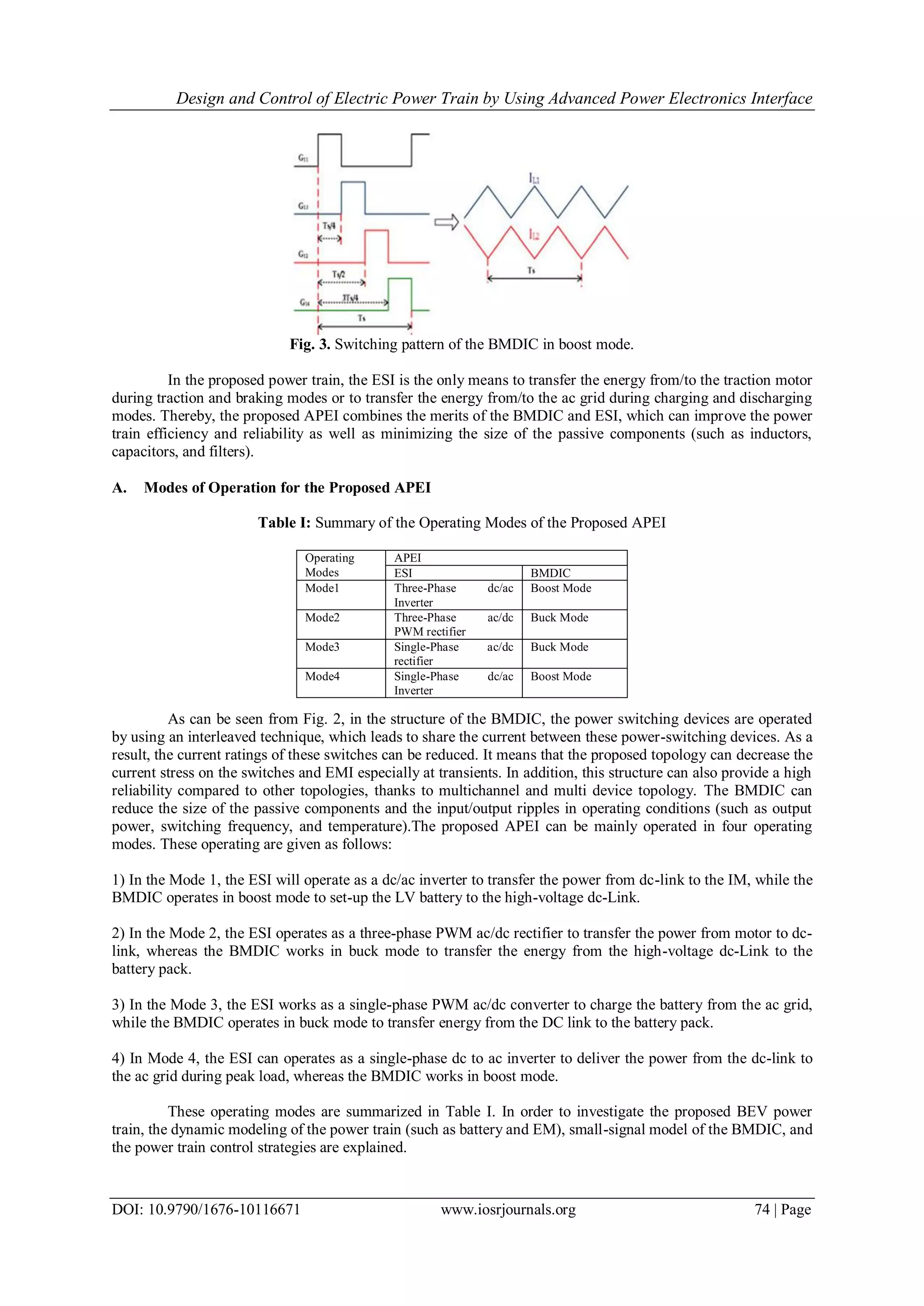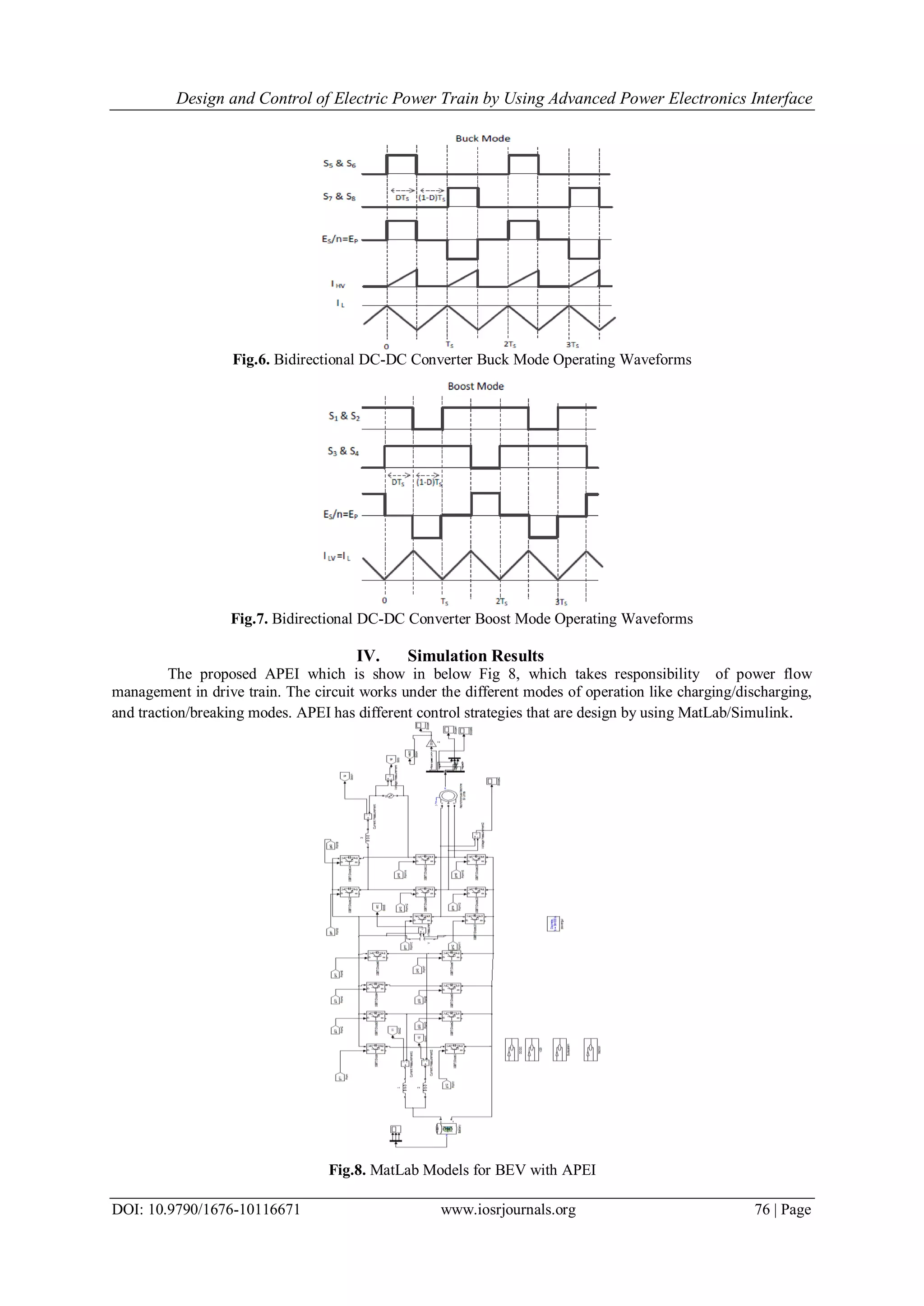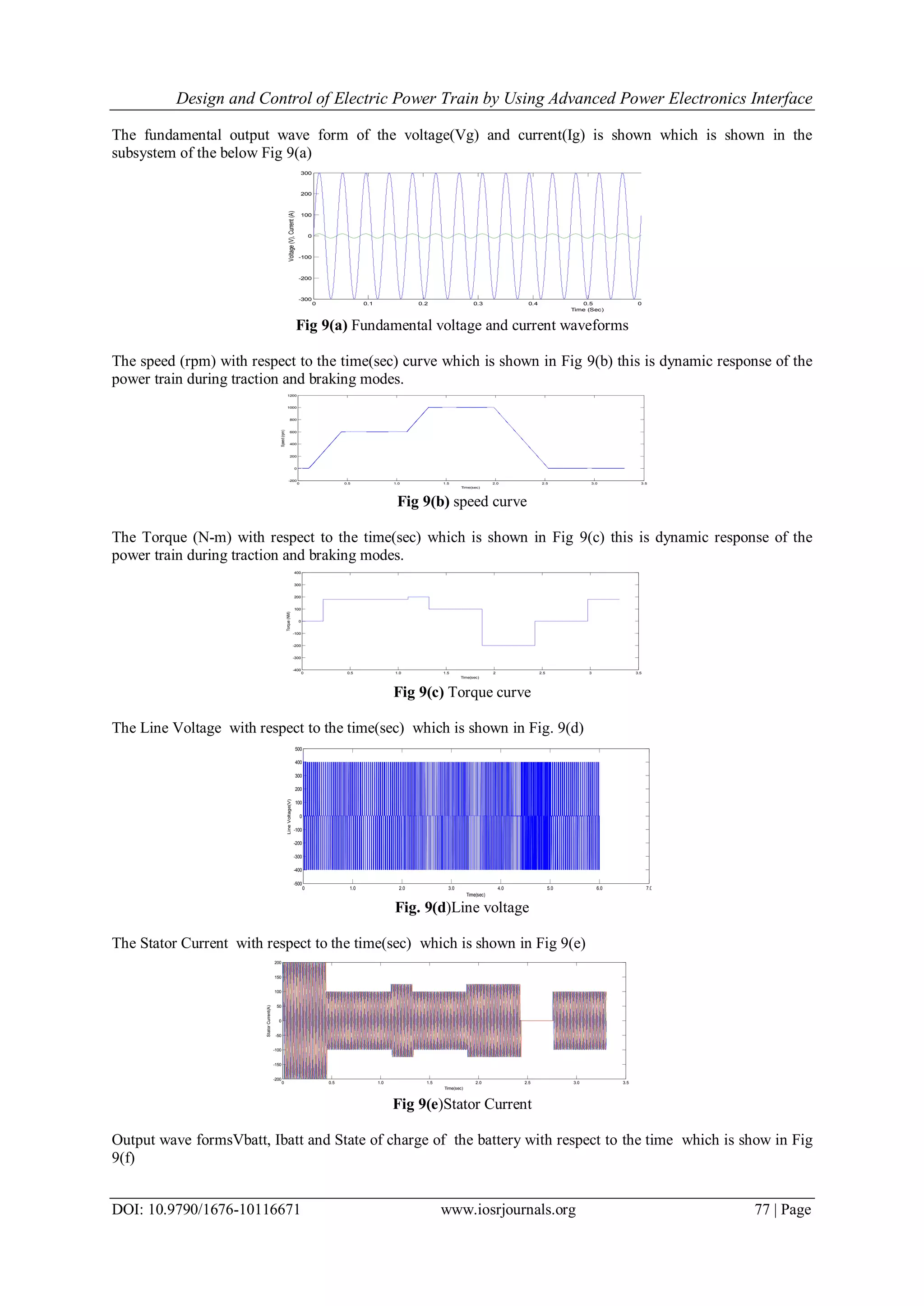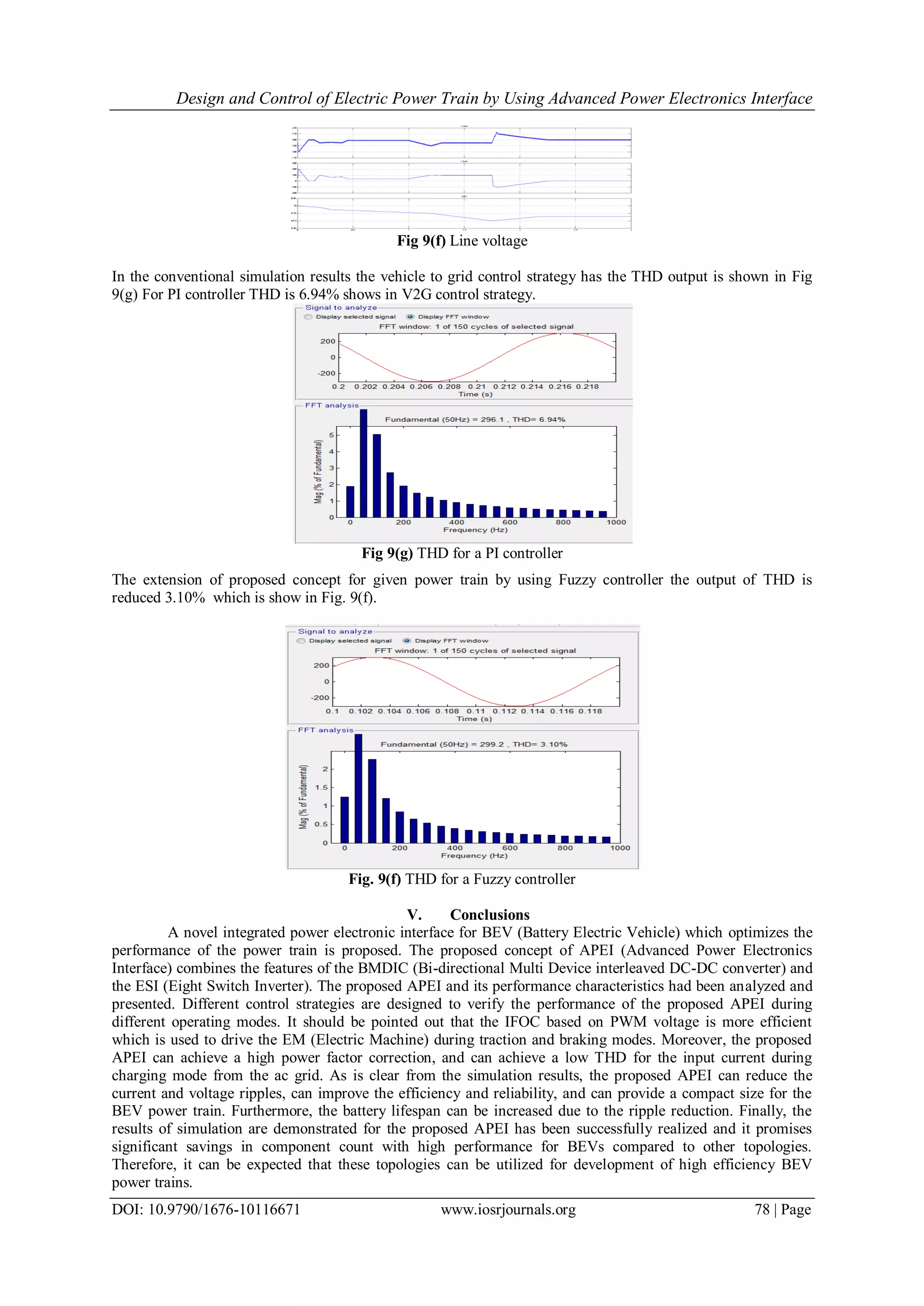This document proposes a new integrated power electronics interface (IPEI) for battery electric vehicles to optimize power train performance. The IPEI combines a bidirectional DC/DC converter, onboard battery charger, and DC/AC inverter. It is responsible for managing power flow during different operating modes like charging/discharging and traction/braking. The concept is designed and simulated in MATLAB/Simulink. Simulation results show output waveforms and validate the design. Specifically, the speed, torque, voltage and current curves demonstrate the dynamic response during traction and braking modes. THD is also reduced from 6.94% using a PI controller to 3.10% with a fuzzy controller, showing improved performance.
![IOSR Journal of Electrical and Electronics Engineering (IOSR-JEEE)
e-ISSN: 2278-1676,p-ISSN: 2320-3331, Volume 10, Issue 1 Ver. I (Jan – Feb. 2015), PP 72-79
www.iosrjournals.org
DOI: 10.9790/1676-10117279 www.iosrjournals.org 72 | Page
Design and Control of Electric Power Train by Using Advanced
Power Electronics Interface
B Gururaj1
, K Rajeshgoud2
and A Mallikarjuna Prasad3
1
Assist. Prof. EEE Dept., at SJCET, Yemmiganur, Kurnool (dist), Andhra Pradesh.
2
PG Student at SJCET, Yerrakota, Yemmiganur, Kurnool (dist), Andhra Pradesh.
3
Assoc. Prof. EEE Dept., at SJCET, Yemmiganur, Kurnool (dist), Andhra Pradesh.
Abstract: A new integrated power electronics interface (IPEI) for battery electric vehicles (BEVs) in order to
optimize the performance of the power train is proposed in this paper. As Power electronics interfaces plays
important role in the automotive vehicle technologies the proposed IPEI is responsible for the power-flow
management for each operating mode. The operating modes will explain how IPEI works during different
modes like charging/discharging and traction/breaking modes. In this concept, an IPEI is proposed and
designed to realize the integration of the dc/dc converter, on-board battery charger, and dc/ac inverter together
in the BEV power train with high performance. The proposed concept improves the system efficiency and
reliability, and reduces the current, voltage ripples, and also reduces the size of the passive and active
components in the BEV drive trains compared to other topologies. And control strategy for IPEI is designed and
analyzed by using MATLAB/Simulink. The simulation results related to the output waveforms are obtained and
validated.
Index Terms: Battery electric vehicles (BEVs), interleaved dc/dc converter, on-board battery charger, power-
train control strategies, power-train modeling, small-signal model.
I. Introduction
A critical factor propelling the shift from conventional gasoline/diesel engine vehicles to electric,
hybrid and fuel cell vehicles is the revolutionary improvement in performance, size, and cost of power
semiconductor switches over the past decade, with parallel improvements in sensors and microprocessors. The
issues to be addressed in the design of HEV power electronics circuits include [1], [2], [3]. Electrical Design:
including main switching circuit design; controller circuitry design; switching frequency optimization; and loss
calculations.
Mechanical and Thermal Design: including modeling of the loss of power devices and magnetic
components; cooling system, heat sink, and enclosure design; and integration of the power electronics unit.
Control algorithm design: including developing the control algorithm to achieve the desired voltage, current
and frequency at the output, and to realize bidirectional power flow as needed.
Magnetic Design: including the design of inductors, transformers, and other components, such as
capacitors, needed for filtering, switching, and Gate driver units. The on-board voltage levels of vehicular power
system have been raised to 42 V, to 300 V, or higher, as the case may be [1], [7], [5] assuming that there is
almost 4% increase in automotive load per year.
Owing to the high voltage levels being produced in HEVs, it becomes essential to have DC/AC
converters to supply all the auxiliary loads on board the vehicle. Although the DC/DC converter technology is
well developed for low-power applications at lower cost, much work needs to be done for high-power
applications. In addition, power electronic converters also dictate how and when fuel/electricity is used in
HEVs.
A suitable inverter draws dc power from the batteries to drive the electric traction motor, which in turn
provides power to the wheels. The inverter also performs the function of recharging the batteries during re-
generative braking in HEVs.](https://image.slidesharecdn.com/l010117279-151119083015-lva1-app6891/75/Design-and-Control-of-Electric-Power-Train-by-Using-Advanced-Power-Electronics-Interface-1-2048.jpg)
![Design and Control of Electric Power Train by Using Advanced Power Electronics Interface
DOI: 10.9790/1676-10116671 www.iosrjournals.org 73 | Page
II. Circuit Topologies
Fig. 1. Typical layout of HEV
Fig. 1 shows the general power train layout of hybrid electric vehicle [1], [5]. The power electronics
unit consists of a bidirectional DC/DC converter that links the lower voltage hybrid battery and the higher
voltage DC bus, and three motor drive circuits that control the front and rear motor/generators. Fig. 1 shows
that other than propelling the vehicle, power electronics converters are used for activation and control of all
other loads such as air conditioning, power steering, fans, pumps, video, and many other hotel and
ancillary loads in sports utility vehicles.
While the detailed circuit of the proposed APEI (Advance power electronics interface) is shown in Fig.
2. In this power train, the battery pack is connected to the dc-link through the BMDIC. The BMDIC comprises
two inductors, eight switches (IGBTs), and eight anti parallel diodes for boost and buck operating modes. The
BMDIC has the ability to reduce the size of the passive components (such as inductors and capacitor), and to
reduce input/ output EMI filters by means of increasing the frequency of inductor current ripple and the output
voltage ripple without increasing the switching frequency.
Fig.2 Detailed circuit diagram of the proposed APEI.
To achieve the control strategy of the BMDIC, a phase-shift interleaved control between phases and
parallel devices is used to generate the switching patterns. These switching patterns are shifted by 360◦
/(n×m)(or
Ts/(2×2)) as shown in Fig. 3, where n is the number of phases or channels per port, while m is the number of the
switches per phase. As can be seen from Fig. 3, the sequence of the driving signals is very crucial to achieve a
doubled ripple frequency in inductor current at the same switching frequency, and to provide the interleaved
control between inductors as well as power switching devices. This sequence can contribute to a higher system
bandwidth compared to bidirectional-interleaved converter (BIC) with four switches (IGBTs) and four diodes.
Furthermore, this control strategy can achieve a fast dynamic response for the proposed converter.](https://image.slidesharecdn.com/l010117279-151119083015-lva1-app6891/75/Design-and-Control-of-Electric-Power-Train-by-Using-Advanced-Power-Electronics-Interface-2-2048.jpg)

![Design and Control of Electric Power Train by Using Advanced Power Electronics Interface
DOI: 10.9790/1676-10116671 www.iosrjournals.org 75 | Page
III. Dynamic Modeling Of Power Train
A. Dynamic Modeling of the Battery System
The battery stores energy in the electrochemical form and is the most widely used device for energy
storage system in the variety of applications such as EVs, HEVs, and PHEVs. Lithium-Ion batteries are
increasingly accepted to be an optimal choice for energy storage in automotive applications.
Fig.4. Thevenin battery model.
The mathematical modeling of the Li-Ion battery package used in the simulation program is defined as
a thevenin battery model. The Thevenin battery model, the most commonly used battery model, consists of an
internal resistance Rint, polarization capacitance Cp, and over voltage resistance (Rp, polarization resistance),
and open circuit voltage Voc. All elements that are used in this model are functions of the battery state of charge
(SoC). Fig.4 illustrates the thevenin battery model. The battery system comprises a package with N batts cells
that are connected in series and N batt p that are connected in parallel. The terminal voltage of the battery pack,
V Batt, can be denoted as follows:
Vbatt= NbattS[Voc-Ibatt.Rint – Vcp] (3.1)
SoC=SoC+
1
3600
∫
𝐼 𝐵𝑎𝑡𝑡
𝐶 𝑏
dt (3.2)
Where
𝐼 𝐵𝑎𝑡𝑡 =
𝐼 𝐿𝑜𝑎𝑑
𝑁 𝐵𝑎𝑡𝑡𝑃
(3.3)
𝑑𝑉𝑐𝑝
𝑑𝑡
= -
𝑉𝑐𝑝
𝐶 𝑝 𝑅 𝑝
+
𝐼 𝐵𝑎𝑡𝑡
𝐶 𝑏
(3.4)
The MATLAB/Simulink-based battery system is designed and modeled in this paper by using the
aforementioned equations.
B. Bidirectional DC-DC Converter
The bidirectional DC-DC converter [12],[13] allows for a bidirectional flow of power to utilize grid
power when necessary and to supply power to the grid when excess power is generated, the bidirectional DC-
DC converter shown in Fig 5. Applications of bidirectional DC-DC converters include battery energy storage
systems, next generation motor drives, interconnecting load centers that possess on site generation. The
bidirectional DC-DC converter used in this concept based off of the one designed.
In this the bidirectional DC-DC converters operation within the context of the EVCS (Electrical vehicle
charge station), will be considered as Buck/Boost mode. In buck mode, the bidirectional DC-DC converter
utilizes constant voltage control to operate as a voltage regulator for the LVDC bus.
Fig.5. Bi direction dc to dc converter
The gating signals and key operating waveforms as well as the converter current paths for the boost and
buck modes of operation for the bidirectional DC-DC converter are presented in above Fig.5 The currents IHV
and ILV are measured using the reference of „going into the converter‟ as the positive direction, which is why IL
is negative in buck mode and positive in boost mode. In boost mode only one current wave form is displayed. .
Bidirectional DC-DC Converter Buck/Boost Mode Operating Waveforms are shown in Fig 6 and Fig 7.](https://image.slidesharecdn.com/l010117279-151119083015-lva1-app6891/75/Design-and-Control-of-Electric-Power-Train-by-Using-Advanced-Power-Electronics-Interface-4-2048.jpg)



![Design and Control of Electric Power Train by Using Advanced Power Electronics Interface
DOI: 10.9790/1676-10116671 www.iosrjournals.org 79 | Page
References
[1]. C. C. Chan, A. Bouscayrol, and K. Chen, “Electric, hybrid, and fuel-cell vehicles: Architectures and modeling,” IEEE Trans. Veh.
Technol., vol. 59, no. 2, pp. 589–598, Feb. 2010.
[2]. C. C. Chan, “The state of the art of electric and hybrid, and fuel cell vehicles,”Proc. IEEE, vol. 95, no. 4, pp. 704–718, Apr. 2007.
[3]. A. Emadi, S. S. Williamson, and A. Khaligh, “Power electronics intensive solutions for advanced electric, hybrid electric, and fuel
cell vehicular power systems,”IEEE Trans. Power Electron., vol. 21, no. 3, pp. 567– 577, May 2006.
[4]. A. Emadi, Y. J. Lee, and K. Rajashekara, “Power electronics and motor drives in electric, hybrid electric, and plug-in hybrid electric
vehicles,” IEEE Trans. Ind. Electron, vol. 55, no. 6, pp. 2237–2245, Jun. 2008.
[5]. S. S. Raghavan, O. C. Onar, and A. Khaligh, “Power electronic interfaces for future plug-in transportation systems,” IEEE Power
Electron. Soc. Newsletter, vol. 23, Third Quarter 2010.
[6]. Y.-J. Lee, A. Khaligh, and A. Emadi, “Advanced integrated bidirectional AC-DC and DC-DC converter for plug-in hybrid electric
vehicles,” IEEE Trans. Veh. Technol., vol. 58, no. 8, pp. 3970–3980, Oct. 2009.
[7]. M. Pahlevaninezhad, P. Das, J. Drobnik, P. K. Jain, and A. Bakhshai, “A new control approach based on the differential flatness
theory for an AC/DC converter used in electric vehicles,” IEEE Trans. Power Electron., vol. 27, no. 4, pp. 2085–2103, Apr. 2012.
[8]. Z-Source Inverter for Fuel Cell Vehicles, Oak Ridge Nat. Lab., Oak Ridge, TN, USA, Sep. 2005.
[9]. S. Miaosen, “Z-source inverter design, analysis, and its application in fuel cell vehicles,” Ph.D. dissertation, Michigan State Univ.,
East Lansing, USA, 2007.
[10]. M.-K. Nguyen, Y.-C. Lim, and G.-B. Cho, “Switched-inductor quasi-Zsource inverter, ” IEEE Transaction.power electron volume
no.26 pp.3183– 3191, Nov. 2011.
[11]. W. Kramer, S. Chakra borty, B. Kroposki, and H. Thomas, “Advanced power electronic interfaces for distributed energy systems,
Part 1: Systems and topologies,” National Renewable Energy Lab., Golden, CO, USA, Tech. Rep. F4, Nov. 2008.
[12]. O. Hegazy, J. Van Mierlo, and P. Lataire, “Control and analysis of an integrated bidirectional DC/AC and DC/DC converters for
plug-in hybrid electric vehicle applications,”J. Power Electron., vol. 11, no. 4, pp. 408– 417, 2011.
[13]. B. Gu, J.-S. Lai, N. Kees, and C. Zheng, “Hybrid-switching full-bridge DC–DC converter with minimal voltage stress of bridge
rectifier, reduced.](https://image.slidesharecdn.com/l010117279-151119083015-lva1-app6891/75/Design-and-Control-of-Electric-Power-Train-by-Using-Advanced-Power-Electronics-Interface-8-2048.jpg)